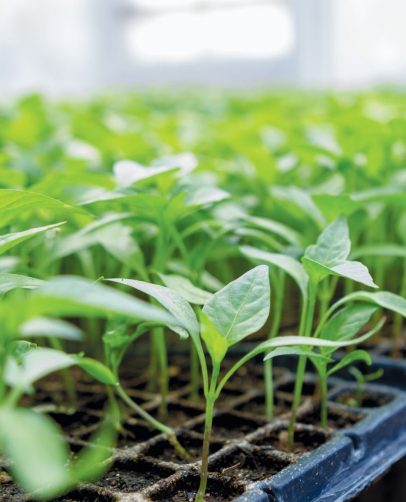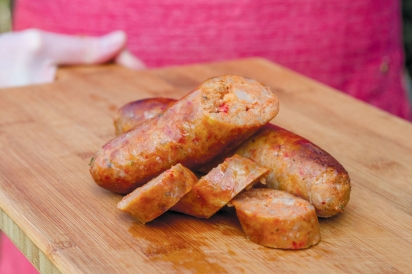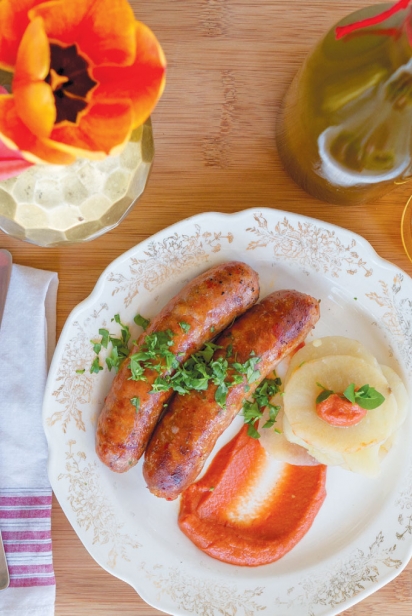From Choricero to Chorizo: The Rare Pepper that Makes Traditional Basque Sausage Sing
Basque chorizo comes in many juicy forms—long and thin, short and fat, studded with garlic or packed with paprika—but the sausage’s defining ingredient, the thing that makes it truly and uniquely Basque, is the choricero pepper.
When it’s very young, the mild green pepper is sometimes blistered in a hot pan and dusted with sea salt. More often, it’s allowed to ripen on the vine to a brilliant red and strung up to dry in long, spiky clusters. As winter settles in, the peppers shrivel into wrinkled, deep burgundy shells that conceal dozens of rattling seeds.
Choricero pepper seeds are a kind of currency in Idaho’s Basque community—if you want to get your hands on top-notch seeds, you’ve got to get in good with a seed saver or a seed smuggler.
“Like everything in choriceros, I knew somebody that knew somebody that knew somebody to get the ‘good seed,’” said Phil Sarasqueta, a Basque choricero grower in Twin Falls.
The choricero peppers grown in Idaho today are descendants of seeds that were once tucked into someone’s coat pocket or stashed in their suitcase on their way over from the Basque country.
“It’s not exactly like we’re trying to sneak in cocaine,” Sarasqueta added with a laugh. “But you know.”
Sarasqueta, a self-proclaimed “newbie” in the choricero-growing scene, has planted around 250 peppers for the last three years. He sows two peppers side-by-side per row, and spaces them exactly a foot apart. Each row is approximately 40 inches away from the next and the plants are watered on a drip irrigation system.
Though these details might seem like gardening minutiae, each factor is a hotly debated subject at Basque bars. After a little wine, the choricero can become an inexhaustible topic of conversation. After a lot of wine, the conversation often dissolves into straight-up bragging, with gardeners boasting that their peppers are bigger, better or more abundant than everyone else’s.
Edwards Greenhouse owner Garnette Edwards has been involved with the plucky Basque pepper-growing community for the last 25 to 30 years.
“My father actually met a lot of these Basque people back in the day when he and his father delivered in the mid to late 1930s to the Basque boarding houses,” said Edwards.
What began with one Basque woman starting her seeds at the greenhouse blossomed to include 20 or more families. Now, every year at the end of February, Basque pepper growers bring their saved seeds to be started at Edwards, some requesting multiple flats. They pick up their starts at the end of May, when they’re around six inches long and ready to be planted.
“They’re kind of secretive and competitive about their peppers,” said Edwards’ daughter, Production Manager Erin Monnie. “They’re always coming in and making sure their peppers are better than the other guys’ peppers. It’s a friendly competition, but it’s really fun. They’re some of my favorite customers.”
Instead of labelling the young choricero starts with their owners’ names, Edwards had to establish a special coding system to prevent pepper fraud.
“We started numbering them because somebody would be, like, ‘It’s OK, I know that person; I can take those,’” said Monnie. “And then that person would come in later and be, like, ‘Oh, I didn’t say that.’ So we had to code them.”
But there’s another code that can work against Basque pepper seeds: genetics. After a few generations, the seedstock tends to slowly evolve due to cross-pollination.
“Over time, a line of peppers kind of deteriorates,” said Sarasqueta. “You save the seeds, grow the peppers, save the seeds, grow the peppers, save the seeds. Unless you’re very, very careful on only picking the very best peppers as your seed peppers … your peppers just aren’t quite as good after several years.”
Many Basque gardeners also plant other old-country pepper varieties, including piquillo, espelette, morrón and gernika—which are often confused with choricero, but have a more pointed tip and are primarily pan-fried and eaten green.
“Most of these fellows grow pimentos and fry peppers so it’ll have some of those characteristics melded together. Or you won’t get a big production out of them, or there will be a glitch,” said Edwards. “Then it’s time to go back to the Basque country and get more seed.”
But that’s changing, too. There are now a couple of seed companies that sell Basque peppers stateside. Secret Seed Cartel, an Ohio farm that specializes in rare or unavailable seed varieties, sells packets of 10 choricero seeds for $4. They also sell Basque espelette and gernika seeds. Locally, the Snake River Seed Cooperative sells gernika and piquillo pepper seeds. And the Basque Market offers bags of dried whole choricero peppers, along with jars of carne de pimiento choricero, or choricero pepper pulp.
Dan Ansotegui, founder of Bar Gernika, has a specific process for turning his dried choriceros into carne de pimiento choricero.
“After they’ve dried, you reconstitute them. The easiest way to do it is to break them apart at the top,” explained Ansotegui. “You take off the stem, you take out the seeds and then you throw them in water. You can either soak them in water for 24 hours like my grandmother used to do, or you can bring them to a boil. As soon as they come to a boil you shut them off and you put a lid on them and let them sit for about an hour and then you put them in a food processor. I always go through a Mouli or a food mill and that gets rid of the thick skin. What you get is this meaty sauce that’s about the consistency of tomato sauce.”
From there, each chorizo recipe varies slightly. Some call for more salt or garlic, while others prefer the flavor of paprika or other peppers. Regardless, the choricero pulp gets folded into the spiced ground pork, staining the mixture a vibrant red. The seasoned meat is then piped into sausage casings and the links are hung to dry-age for a couple of days or longer in a cool place.
“It’s very much an art, not a science,” said Sarasqueta, referring to the chorizo process.
Sarasqueta’s family experiments with different recipes and methods for making chorizo every winter at their traditional matanza (Spanish for “slaughter” or “killing”) held in California.
“For generations now, there’s been some Basque family that got together every January and killed pigs and made all kinds of sausage—morcilla, chorizo, home-cured hams, bacon, the whole nine yards,” said Sarasqueta. “Everything but the squeal.”
If you weren’t invited to a matanza this year, you can still sink your teeth into a plump chorizo at Jaialdi, a boisterous Basque event that storms Boise every five years in late July. Gem Meat Packing Co. in Garden City will supply the festival with Basque chorizos, which owner Brent Compton says are made with medium-spicy dried “chili pods” from California and Texas since choricero peppers aren’t grown commercially. For Jaialdi alone, which runs from Tuesday, July 28, through Sunday, Aug. 2, the company anticipates selling around 20,000 chorizos.
“It started out with Basque people eating them,” said Basque Museum Director Patty Miller. “But now you can buy chorizos at the hot dog stands on all the corners.”
Jaialdi 2015 Schedule
Every five years, Boise hosts a big Basque blowout called Jaialdi. In 2010, organizers estimated around 30,000 people attended, and they expect 2015 to be even bigger. If you’re looking to sample Basque chorizo, throw back a few kalimotxos (red wine and cola) or just soak up some Basque culture, here’s the full schedule of events happening this year:
Tuesday, July 28–Wednesday, July 29
Welcome to Boise
Basque Block, 5–11pm, free
Head down to the Basque Block for food, drinks and live music.
Thursday, July 30
Sports Night
CenturyLink Arena, 7pm, $15
Weightlifters from the Basque Country will hoist 250- to 400-pound cylinders and 350-pound stone balls. There will also be woodchopping and traditional farm sports, where competitors throw hay bales, lift wagons and see who can carry milk cans the farthest.
Street Dance
Basque Block, 8:45pm, free
Dancing with live music by Luhartz and The Crazy Wheels.
Friday, July 31
Basque-ing on the Block
Basque Block, noon–6pm, free
Grab some food, get a drink and listen to Basque music.
Festa’ra
Morrison Center, 7pm, $35
A celebration of traditional Basque music and dance, including performers from Euskadi and Boise’s Oinkari Dancers.
Saturday, August 1
Basque-ing at Expo Idaho
Expo Idaho, 10am–6pm, $6.50 online, $7 gate,
free for kids under 10
Dozens of dance groups from around the West will perform on two indoor stages. Basque vendors will sell Basque novelties, souvenirs and clothing. Food, drinks and sheep wagon displays will also be available.
San Inazio Mass
St. Mark’s, 7960 Northview St., 7pm, free
The annual San Inazio Mass will be celebrated in Basque and English. The Oñati Dancers will perform a sacred liturgical dance on the altar, with assistance from the Oinkari Basque Dancers.
Dance
Expo Idaho, 9pm–1am, $11.50 online, $12 gate
Dancing with music from Amuma Says No and The Crazy Wheels.
Open to all ages.
Sunday, August 2
Basque-ing at Expo Idaho
Expo Idaho, 11am–5pm, $6.50 online, $7 gate, free for kids under 10. See Saturday’s description.
Street Dance
Basque Block, 8pm, free
Dancing with music by Luhartz and Amuma Says No.







